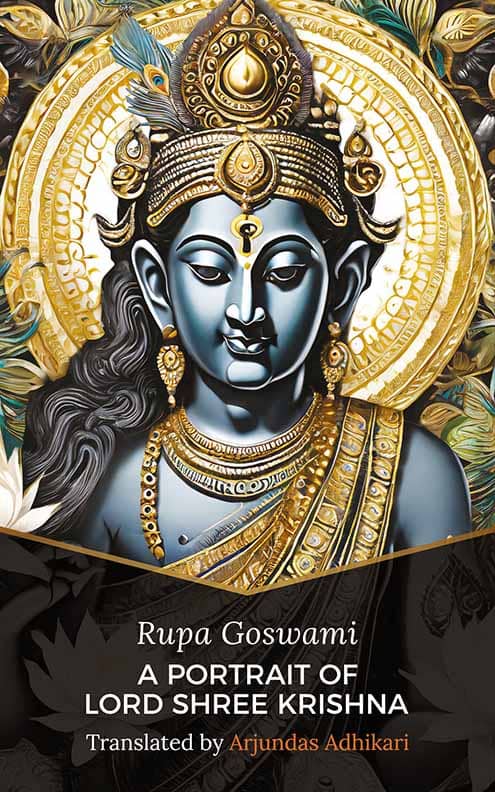
The earliest Sanskrit dramas with the same theme as Vidagdha Madhava (aka, A Portrait of Lord Shree Krishna, translated from the Sanskrit by Arjundas Adhikari), viz. the pastimes of the incarnation of Lord Shree Krishna, were written by the playwright, Bhasa, in the 4th century BCE. His two principal plays are Balacharitam and Dutavakyam, which are still performed and have been admired by Indian poets and scholars for centuries, notably by Kalidas, the most famous of all writers of Hindu drama of the 1st century CE.
The disposition for writing and staging plays based on the same theme of A Portrait of Lord Shree Krishna (aka Vidagdha Madhava), can be attributed to the many exhortations to do so that are found in the Vedas (Sanskrit scriptures) themselves. For example, here is a personal recommendation made by Krishna Himself that is mentioned in the Bhagavata Purana:
upagayan grinan nrityan
karmany abhinayan mama
mat-kathah shravayan shrinvan
muhurtam kshaniko bhavet
“One should always engage in songs, dances or plays that depict My life on earth.”
Bhagavata Purana 11.27.44
In the Mahabharata of Jaimini, one actor is recorded as saying:
Dear yogis, through my singing, dancing and acting, I am able to directly see whom you’ll get to see only with difficulty, even with all your rigid austerities and meditation. It would appear there’s little doubt as to the best way of approaching Shree Krishna.
Proponents of classical Indian aesthetics (rasa) point out that the purpose of any art-form is to affect emotion. Artists, having been emotionally inspired by something extraordinary, devise paintings, songs, or dramas in order to re-invent that emotionally-charged inspiration in the hearts of their audience through their chosen art form. This is not dissimilar to the Aristotlean idea that art should be emotionally cathartic. Such ideas make as much practical sense today as they ever did.
The writing of the Sanskrit drama Vidagdha Madhava by Rupa Goswami is demonstrably part of a long established tradition of devout Krishna-ites who have composed dramas concerned with the brilliant, ingenious, insightful, revolutionary and heroic nature of their divine swami, Shree Krishna. This is apparent from the volume of extant Sanskrit dramas, prior to Rupa Goswami, that focus on this theme (apart from the many that have been lost). There follows a list of some pre-eminent Indian Sanskrit playwrights and the dramas they wrote to share with us their passion for Krishna and His incarnations.
- (4th century BCE) Bhasa: Balacharitam, Dutavakyam
- (2nd century BCE) Patanjali: Mahabhashya – refers to dramas about Krishna that precede Bhasa, even
- (8th century CE) Bhavabhuti: Mahavira-charita, Uttara-rama-charita (about Krishna’s Rama incarnation)
- (8th century CE) Murari: Anargha-raghava (also about Rama)
- (9th century CE) Rajashekhara: Balabharata, Karpuramanjari, Balaramayan (also about Rama)
- (8th century CE) Kavi Bhatta Narayan: Venisanhaar
- Anon [pre-11th century]: Balika-vanchikam, Yadavabhyudayam, Radha-vipralambha
- (10th century CE) Kulashekhara: Subhadra-dhananjaya
- (12th century) Jayadeva: Gita Govinda
- (13th century) Ravivarman – Pradyumna-bhyudaya
- (15th century) Ramananda Ray: Jagannatha Vallabha Natakam
- (16th century CE) King Prataparudra’s rolling performances of Jayadeva’s Gita Govinda in the Puri Temple
Arjundas Adhikari

